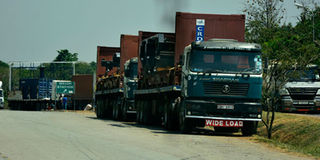TZ charges Ugandan trucks Shs1.8m each

Trucks at a border. Ugandan trucks entering Tanzania are charged Shs1.8 million each regardless of the distance covered. FILE PHOTO
What you need to know:
- Customs department of Uganda Revenue Authority recently oversaw the installation of a new scanner which will help to detect concealment, a major challenge at custom points.
- In a wide-range interview with the Daily Monitor’s Ismail Musa Ladu, the tax body’s commissioner for customs, Mr Collins Dicksons Kateshumbwa explains how they are dealing with non-compliance.
Uganda has asked Tanzania to consider 24-hour border operations. Why is that important to Uganda?
This is a case with Mutukula One-Stop Border Post (OSBP), which is our main gateway entry on the Central Corridor that serves mainly cargo from Dar-es-Salaam Port. Considering that we already have 24-hour operations at other OSBPs such as Busia, Malaba, Katuna and so Mutukula must have the same arrangement so that the business community is facilitated round the clock. Uganda Revenue Authority (URA) is in the process of beefing up the staff at Mutukula to ensure that this 24 hour operation is fully realised.
There is a discrepancy between charges for clearing agents for Uganda imposed by Tanzania. How is that being resolved?
This is about the discrepancy on the road user charges levied by Tanzania of $500 (about Shs1.8 million) on Ugandan trucks entering Tanzania regardless of the distance covered in comparison to Uganda charges of $0.1 and $.0.6 per kilometre for trucks more than three axles or less than that. This matter has been escalated to the highest authorities and Tanzania promised to review the charges. But as we speak, Ugandan trucks are still being charged the same road user fee.
How is the OSBP fairing so far in terms of its contribution to custom revenue and trade facilitation
Currently, we have four OSBPs operating fully. They include Malaba, Busia, Mutukula, and Mirama Hills. Elegu OSBP construction has been completed and will be operationalised very soon while works that had stalled at Katuna OSBP have resumed. A study undertaken at Busia OSBP indicated that since the operationalisation of OSBP, clearance time at the border was cut down by over 70 per cent. We expect to see the same impact in the other OSBP as well.
We have also seen increased volumes of cargo save for Mirama Hills which is still struggling with low volumes. In terms of contributing to revenue Malaba, Busia and Mutukula are among the top four contributors to revenue.
What was the performance of customs in terms of revenue to the overall revenue target in the just ended financial year?
As always just know that we never stop to try to achieve our targets. And importantly, at URA we work as a team and deliver as a team.
What are the next plans after hosting a successful Authorised Economic Operator (AEO) Global Conference?
The AEO programme is progressing well. After the successful conference, we got a lot of interest from the business community and the impact on the compliance behaviour has been positive.
So far, we have 56 companies on the AEO programme at national level and 23 companies with the regional AEO Status.
We hope to grow these numbers with more focus on Small and Medium Enterprises by creating a tier rating system so that we grow companies from low levels of compliance and security upwards.
We have also started discussions with China, India and South Korea on Mutual Recognition Agreements. We have already signed the AEO –MRA Implementation road map with the three countries.
Any challenges that the Customs department is grappling with?
Our major challenge is non-compliance along the trade supply chain by actors. This behaviour is manifested in different forms such as smuggling, undervaluation, concealment, and document fraud, among others.
How are you addressing these challenges?
We have established various strategies such as the latest deployment of scanners at the borders to detect concealment.
We strengthened our intelligence function, stepped up anti-smuggling focused operations, robust transit monitoring through electronic cargo tracking system, 24-hour surveillance on lakes and porous borders.
We strengthened valuation by developing Tariff Specification Codes, doing more research on key products, and strengthening risk management by establishing a National Targeting Centre.
We also plan to establish customs attaches to key trading partners such as China to conduct product valuation research and verification.
Last financial year, we had 8,918 interceptions (seizures) with a revenue recovery of more than Shs60 billion. We developed 6,750 Tariff Specification Codes yielding a revenue gain of more than Shs30 billion.
The plan is to consolidate these measures this year and over the coming years.
Where is the role of customs headed in the next five to 10 years?
Our main focus is twofold— trade facilitation and enhancing compliance to yield revenue collection. You will appreciate that more than 70 per cent of imports are not dutiable. We are a major transit route and we have seen our exports grow.
We, therefore, have to respond appropriately by ensuring that we balance our focus and perform our roles to the best of our abilities.
As more investments and industries take fold, we must be ready to facilitate them to quickly set up, manufacture and export. This will lead to growth and revenue will be realised later through income tax and VAT among others.
Uganda has now ratified the Trade Facilitation Agreement (TFA) and Customs is central in implementing the provisions of the TFA.




